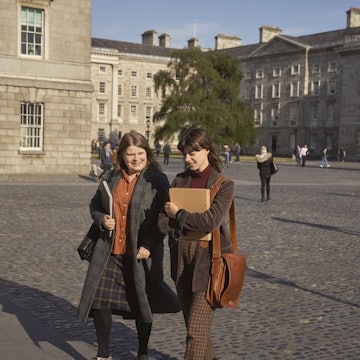

Even when social distancing, these books will whisk you away to European local. Basak Gurbuz Derman / Getty Images
Wandering the streets of great European cities one row of typeset print at a time is a centuries old tradition – one that still allows readers to travel not only through countries and across the continents, but in and out of time as well.
There's never been a better time to tuck into literary visions of storied streets, from Vienna to Višegrad, Seville to Oslo, London to Istanbul.

These novels (and the occasional work of nonfiction) will carry you to the diverse suburbs of post-colonial Britain, back to the heady days of the Prague Spring in 1960s Czechoslovakia, across Icelandic lava fields, high into the Alps, and through the plazas of Paris – with plenty of insight into the human condition to consider along the way. You won't need your passport, but you may need a bookmark or two.
Our editors independently select the best products to help you have amazing travel experiences. If you purchase through links on our site, Lonely Planet may earn a commission from the retailer.
Europe
Flights by Olga Tokarczuk
Polish author Olga Tokarczuk won both the Nobel Prize in Literature and the Man Booker International, but don't expect a straightforward novel when you tuck into Flights. Instead, you'll find a work that is impressionist and postmodern, taking the form of interwoven vignettes that add up to a larger whole: a meditation on the nature of travel and the experiences to be found in airports and hotel lobbies, zinging from museums to cruise ships to St. Vitus Cathedral, from Prague to Vienna to Warsaw, while darting through the ouvres of great European writers and artists through the ages (Chopin in particular). It's a wholly unique style the New Yorker attempted to pin down as "flâneurial essayism" and sure enough, by the end you'll feel as you've been on a truly epic stroll through Europe.
Iceland
Names for the Sea: Strangers in Iceland by Sarah Moss
It's a common enough experience to fantasize about living in another country, but not everyone actually makes the leap. Sarah Moss falls into the latter group, moving her small family from Kent in the UK to Reykjavík. She finds herself immersed not only in a completely different language and landscape, but a disorienting mix of stark reality and folkloric fantasy, catching the tail end of Iceland's economic depression and the recent eruption Eyjafjallajokull in an otherworldly place that still believes in elves.
Bosnia & Hercegovina
The Bridge on the Drina by Ivo Andrić
Using the titular 300-year-old bridge as an anchor, Andrić dips as far back in the history of what is now Bosnia & Hercegovina as the 16th century and brings the reader up to World War I, tracing the lives of ordinary people over three centuries as they crisscross the Drina River. From the days of the Ottoman Empire to the assassination of Archduke Ferdinand, Andrić manages to blend history and fiction in compelling ways. You'll definitely want to add the bridge (now a UNESCO World Heritage site) to your bucket list after reading, along with the Museum of Ivo Andric in Višegrad.
England
City of the Mind by Penelope Lively
An architect contemplates past and present in London, a city that reflects both history and modernity in its face, from the new project he's working on in the Docklands to the remnants of the Blitz – and centuries past – scattered throughout the streets of England's capital. The intimacy and specificity of this novel is palpable, and you'll swiftly find that, like the protagonist, "the city [has you] in its current."
You may also like: E2 beyond Shoreditch: a guide to east London's coolest postcode
Portugal
The Year of the Death of Ricardo Reis by José Saramago
Set against the backdrop of the rise of fascism in 1930s Portugal, the titular Doctor Reis returns from Brazil and finds himself in a state of aimlessness. He roams from ship to tram to city, street by winding street, contemplating (and attempting to write) poetry and losing his time in the company of women, all the while drenching the reader in the sights, sounds, and details of Lisbon as he experiences and recalls hem.
Ukraine
The Museum of Abandoned Secrets by Oksana Zabuzhko
Protagonist Daryna Goschynka is a television journalist who uncovers secrets both historic and immediate as she researches a Soviet-era woman named Olena Dovganina and investigates the sudden death of her friend, a contemporary female painter. Along the twists and turns of this plot, Zabuzhko blends genres and evokes the great Russian novelists in her expansive style, giving readers a crash course in the history of Ukraine from World War II to the Orange Revolution, not to mention a stunning tour of Kyiv and Lviv.
Turkey
The Black Book by Orhan Pamuk
A lawyer named Galip becomes obsessed with his wife's disappearance, even to the point of losing his identity. He combs the city of Istanbul for clues, from Aladdin's shop and the Palace Theater to the banks of the Bosporus. The level of detail Pamuk conjures up is intense and captivating, with such memorable imagery as sunken submarines rusting off the decrepit Shore Road and the wrecks of old Cadillacs driven off cliffs by gangsters who could easily inhabit a Bruce Springsteen song. The effect of all that maximalism and mystery is a dizzying effect not unlike wandering Istanbul yourself for the first time. No wonder The Black Book is hailed as a Turkish cult classic.
Spain
The South by Colm Tóibín
A tale of Irish émigrés in Barcelona a decade after the Spanish Civil War, Tóibín's stunning novel is full of rich descriptions that put you amidst Spain's hard light, its plazas and midday heat, on train excursions to San Sebastian, trips to the Pyrenees, and dining at the Hotel Colon across from the famed La Catedral. The main character is an aspiring painter who's drawn to both an Irishman and a Spanish anarchist who fought in the war – relationships that illuminate how places and people evolve, and what it means to from somewhere.
Russia
Petersburg by Andrei Bely
There is no shortage of great literature to come out of Russia, but this is one of the lesser-known and more accessible works. Rather than a sprawling multi-family epic like War and Peace (which is having a moment during the pandemic thanks to the #TolstoyTogether digital book club), Bely's Petersburg operates as a political thriller – a race against a bomb going off in a city on the verge of revolution. This puts the reader right in the heart of St. Petersburg at its most frenetic, with lively modernist descriptions of the city from St. Isaac's Cathedral to the "blackish grey cubes of houses" to the statue of Peter the Great, the Bronze Horseman.
Czech Republic
Time's Magpie: A Walk in Prague by Myla Goldberg
A travelogue as eclectic as Prague itself, Time's Magpie examines the city like an artifact in a museum, in all of its contours, crevices, and cracked fragmentations. Myla Goldberg touches on pivotal moments in Prague' long history that have reshaped the streets you might walk today, from Westernization in the 1990s to natural disasters in the 2000s to our continued fascination with and appreciation for the romantic old architecture that endures. By the end you'll feel you've strolled Prague's streets and seen corners of the city you might never have noticed before.
Germany
Midsummer Night by Uwe Timm
A sensory, mad-cap tragicomedy about a writer struggling to complete an article on – of all things – potatoes sends both protagonist and reader from Milan to colorful post-reunification Berlin. Along the way, the narrator meets an array of former East and West Berliners struggling to make sense of how the city is changing – and how their own identities and sense of purpose have shifted, too.
Greece
A Separation by Katie Kitamura
After her ex-husband goes missing in southern Greece, a young woman settles into a rural luxury hotel there to contemplate the end of their marriage and his disappearance. She is drawn into life in the rugged fishing village, and into contemplations of presence and translation that will be familiar to anyone who has found themselves far from the familiarity of home. Compared by some to Elena Ferrante, author of the beloved Neopolitan novels, Kitamura packs her unfurling noir with a firm sense of place that grounds the narrator's introspection.
Austria
Waiting for Sunrise by William Boyd
William Boyd came up with the idea for Waiting for Sunrise after a visit to the Freud Museum, located in the famous doctor's old apartment at Berggasse 19. He set out to evoke Vienna just before World War I forever altered Europe with this story of an English actor drawn into a spy caper while trying to seek psychoanalysis abroad. Though the story moves at times to London, France, and Geneva, its heart is in The City of Dreams.
Ireland
Eggshells by Caitriona Lally
There are many books by great Irish authors that feature Dublin such that it almost becomes a character in its own right – most notably James Joyce's Ulysses. But Lally manages something a little different in Eggshells, though, like Leopold Bloom, her protagonist spends a great deal of time roaming Dublin's neighborhoods – in this case, to assuage her loneliness. Dublin becomes the friend Lally lacks, a kind of constant companion, in this psycho-geographic novel that shows how place can become an extension of self, a map of the city standing in for a map of the heart.
You may also like: How learning Gaeilge in Ireland expanded more than my vocabulary
Norway
The Ice Palace by Terjei Vesaas
The Ice Palace is not a long novel, but it is lyrical and lovely in is depiction of the rural Norwegian landscape, all icy waterfalls and frozen fjords, a secret kingdom where two young friends grapple with their coming of age. You'll quickly see why this has become a classic in Norway since it was first published in the 1960s, full of beauty, wonder, and danger.
Switzerland
We're Flying by Peter Stamm
This collection of stories moves through Switzerland from its mountain hotels to its forests, Lake Constance to alpine villages, train lines and the homes of ordinary Swiss people living their lives – falling in love, going to school, and even visiting IKEA. The vignettes offer psychological and existential insight, but also deem the Swiss landscape equally worthy of linger attention and consideration.
Hungary
Prague by Arthur Phillips
Contrary to its title, this novel takes place in Budapest, where five American expats contemplate their ideas about Prague and post-Cold War Europe in the early 1990s. Along they way they drift between nightclubs and cafes, coffee houses and streetscapes, stumbling across so much of what makes Budapest lively and unique even as they battle a case of the "anywhere-but-here's." Phillips manages to depict not only the look of Hungary's capital, but its mood and culture too, evoking a freshly independent Budapest as new and uncertain as the characters themselves.
Scotland
Valley at the Centre of the World by Malachy Tallack
Set not in the curving medieval streets of Edinburgh, but instead the rural wilds of Shetland, Malachy Tallack's novel is evocative and organic, portraying the lives of Scottish crofters and an outsider meeting them for the first time. The dialogue is even carefully written in Shaetlan, the local dialect, bringing the characters' voices to life much as Tallack's prose does the rugged landscape.
Italy
The Lying Life of Adults by Elena Ferrante
Few writers are as committed as Elena Ferrante to capturing the spirit of Naples in all of its contradictions, foibles, and details through the eyes of its citizens. She brought the historic city to life in her beloved Neopolitan quartet (now also a TV show), but here in her latest work, she examines class and privilege in a more recent period – the early 1990s. As is often the case in Ferrante's work, this is a bildungsroman that is rooted in a young girl's negotiation of adolescence, mixed with acute descriptions of everyday Italy.
Romania
Life Begins on Friday by Ioana Parvulescu
It's a pleasure to dive into this well-researched historic fiction set in Belle Epoch Bucharest over just thirteen days as 1897 draws to a close. There are elements of science fiction and fantasy here, with the plot being set off by the mysterious appearance of a time-traveling journalist whose sudden arrival contrasts the daily lives of the other characters, their quotidian business interrupted by the strange event. But the various threads of plot and character are so firmly centered in bustling Bucharest that you feel that you are there – and that the city is a character in and of itself.
The Netherlands
Last Call by Harry Mulisch
1970s and '80s Amsterdam comes to life in Mulisch's tale of an aging actor who is tapped to play one last leading role, pulling him out of a stultifying suburban existence and back into the vibrant Amsterdam theater scene. It's a novel haunted – like the Netherlands itself – by the Holocaust, and one with many layers (as one might expect from a novel with a play at its heart), making this a compelling way to peel back your assumptions and associations about The Venice of the North as you follow the protagonist back into the city's heart.
France
Paris to the Moon by Adam Gopnik
Americans in particular have a unique obsession with France, both real and imagined, and New Yorker veteran Adam Gopnik taps into that Francophilia in his memoir of moving to Paris in the mid 1990s with his young family. He conjures up Jardin du Luxembourg, the famed Left Bank, the Jardin des Tuileries, Musée d'Orsay, and endless bistros as he examines the expat experience, and what makes the City of Light so endlessly special.
You may also like: Why now is the perfect time to find a penpal
Belgium
Bruges-La-Morte by Georges Rodenbac
A moody, sometimes brooding, yet beautifully rendered novel captures late 19th-century Bruges. In Rodenbac's time, the city struggled with a sense of faded glory after the River Zwijn filled with sand and ceased to connect the Bruges' canals to the North Sea. The novel's protagonist meditates on the losses that haunt him much as Bruges is haunted by its own Golden Era, even as the city inspires a new generation of French and Belgian artists and composers.
Europe
People of the Book by Geraldine Brooks
Brooks captures Europe's long, tangled history in a glittering novel that follows a rare illuminated manuscript – the Sarajevo Haggadah – across the continent and through the centuries. After the Haggadah is saved from shelling during the Bosnian war, the protagonist begins to study it, tracing its history to fin-de-siècle Vienna, Renaissance era Venice, Barcelona at the dawn of the colonial era, and medieval Seville. It's a story made all the more remarkable by its real-life, true-story roots, and by Brooks' splendid prose.













